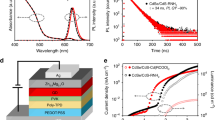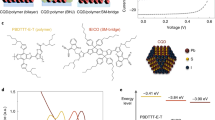Abstract
The external quantum efficiencies of state-of-the-art colloidal quantum dot light-emitting diodes (QLEDs) are now approaching the limit set by the out-coupling efficiency. However, the brightness of these devices is constrained by the use of poorly conducting emitting layers, a consequence of the present-day reliance on long-chain organic capping ligands. Here, we report how conductive and passivating halides can be implemented in Zn chalcogenide-shelled colloidal quantum dots to enable high-brightness green QLEDs. We use a surface management reagent, thionyl chloride (SOCl2), to chlorinate the carboxylic group of oleic acid and graft the surfaces of the colloidal quantum dots with passivating chloride anions. This results in devices with an improved mobility that retain high external quantum efficiencies in the high-injection-current region and also feature a reduced turn-on voltage of 2.5 V. The treated QLEDs operate with a brightness of 460,000 cd m−2, significantly exceeding that of all previously reported solution-processed LEDs.
This is a preview of subscription content, access via your institution
Access options
Access Nature and 54 other Nature Portfolio journals
Get Nature+, our best-value online-access subscription
$29.99 / 30 days
cancel any time
Subscribe to this journal
Receive 12 print issues and online access
$209.00 per year
only $17.42 per issue
Buy this article
- Purchase on Springer Link
- Instant access to full article PDF
Prices may be subject to local taxes which are calculated during checkout






Similar content being viewed by others
References
Reineke, S. Complementary LED technologies. Nat. Mater. 14, 459–462 (2015).
Shirasaki, Y., Supran, G. J., Bawendi, M. G. & Bulović, V. Emergence of colloidal quantum-dot light-emitting technologies. Nat. Photon. 7, 13–23 (2013).
Colvin, V. L., Schlamp, M. C. & Alivisatos, A. P. Light-emitting-diodes made from cadmium selenide nanocrystals and a semiconducting polymer. Nature 370, 354–357 (1994).
Dai, X. et al. Solution-processed, high-performance light-emitting diodes based on quantum dots. Nature 515, 96–99 (2014).
Cho, K.-S. et al. High-performance crosslinked colloidal quantum-dot light-emitting diodes. Nat. Photon. 3, 341–345 (2009).
Qian, L., Zheng, Y., Xue, J. & Holloway, P. H. Stable and efficient quantum-dot light-emitting diodes based on solution-processed multilayer structures. Nat. Photon. 5, 543–548 (2011).
Mashford, B. S. et al. High-efficiency quantum-dot light-emitting devices with enhanced charge injection. Nat. Photon. 7, 407–412 (2013).
Dai, X., Deng, Y., Peng, X. & Jin, Y. Quantum-dot light-emitting diodes for large-area displays: towards the dawn of commercialization. Adv. Mater. 29, 1607022 (2017).
Shen, H. et al. High-efficiency, low turn-on voltage blue-violet quantum-dot-based light-emitting diodes. Nano Lett. 15, 1211–1216 (2015).
Li, Z. et al. Efficient and long-life green light-emitting diodes comprising tridentate thiol capped quantum dots. Laser Photon. Rev. 11, 1600227 (2017).
Coe, S., Woo, W.-K., Bawendi, M. & Bulović, V. Electroluminescence from single monolayers of nanocrystals in molecular organic devices. Nature 420, 800–803 (2002).
Yang, Y. et al. High-efficiency light-emitting devices based on quantum dots with tailored nanostructures. Nat. Photon. 9, 259–266 (2015).
Shirasaki, Y., Supran, G. J., Tisdale, W. A. & Bulović, V. Origin of efficiency roll-off in colloidal quantum-dot light-emitting diodes. Phys. Rev. Lett. 110, 217403 (2013).
Dolzhnikov, D. S. et al. Composition-matched molecular “solders” for semiconductors. Science 347, 425–428 (2015).
Tang, J. et al. Colloidal-quantum-dot photovoltaics using atomic-ligand passivation. Nat. Mater. 10, 765–771 (2011).
Chuang, C.-H. M., Brown, P. R., Bulović, V. & Bawendi, M. G. Improved performance and stability in quantum dot solar cells through band alignment engineering. Nat. Mater. 13, 796–801 (2014).
Zhang, H., Jang, J., Liu, W. & Talapin, D. V. Colloidal nanocrystals with inorganic halide, pseudohalide, and halometallate ligands. ACS Nano 8, 7359–7369 (2014).
Kovalenko, M. V., Scheele, M. & Talapin, D. V. Colloidal nanocrystals with molecular metal chalcogenide surface ligands. Science 324, 1417–1420 (2009).
Choi, J. J. et al. Photogenerated exciton dissociation in highly coupled lead salt nanocrystal assemblies. Nano Lett. 10, 1805–1811 (2010).
Sun, L. F. et al. Bright infrared quantum-dot light-emitting diodes through inter-dot spacing control. Nat. Nanotech. 7, 369–373 (2012).
Lee, K.-H. et al. Over 40 cd/A efficient green quantum dot electroluminescent device comprising uniquely large-sized quantum dots. ACS Nano 8, 4893–4901 (2014).
Owen, J. S., Park, J., Trudeau, P.-E. & Alivisatos, A. P. Reaction chemistry and ligand exchange at cadmium−selenide nanocrystal surfaces. J. Am. Chem. Soc. 130, 12279–12281 (2008).
Zanella, M. et al. Atomic ligand passivation of colloidal nanocrystal films via their reaction with propyltrichlorosilane. Chem. Mater. 25, 1423–1429 (2013).
Ji, C. et al. 1,2-Ethanedithiol treatment for AgIn5S8/ZnS quantum dot light-emitting diodes with high brightness. ACS Appl. Mater. Inter. 9, 8187–8193 (2017).
Daekyoung, K. et al. Improved electroluminescence of quantum dot light-emitting diodes enabled by a partial ligand exchange with benzenethiol. Nanotechnology 27, 245203 (2016).
Pan, J. et al. Highly efficient perovskite-quantum-dot light-emitting diodes by surface engineering. Adv. Mater. 28, 8718–8725 (2016).
Yang, Z. et al. All-quantum-dot infrared light-emitting diodes. ACS Nano 9, 12327–12333 (2015).
Dirin, D. N. et al. Lead halide perovskites and other metal halide complexes as inorganic capping ligands for colloidal nanocrystals. J. Am. Chem. Soc. 136, 6550–6553 (2014).
Bae, W. K. et al. Highly efficient green-light-emitting diodes based on CdSe@ZnS quantum dots with a chemical-composition gradient. Adv. Mater. 21, 1690–1694 (2009).
Bae, W. K., Nam, M. K., Char, K. & Lee, S. Gram-scale one-pot synthesis of highly luminescent blue emitting Cd1−xZn x S/ZnS nanocrystals. Chem. Mater. 20, 5307–5313 (2008).
Lim, J. et al. Influence of shell thickness on the performance of light-emitting devices based on CdSe/Zn1–xCd x S core/shell heterostructured quantum dots. Adv. Mater. 26, 8034–8040 (2014).
Adachi, M. M. et al. Microsecond-sustained lasing from colloidal quantum dot solids. Nat. Commun. 6, 8694 (2015).
Lan, X. et al. Passivation using molecular halides increases quantum dot solar cell performance. Adv. Mater. 28, 299–304 (2016).
Ning, Z. et al. Air-stable n-type colloidal quantum dot solids. Nat. Mater. 13, 822–828 (2014).
Di Raddo, P. A convenient method of esterification of fatty acids: An undergraduate organic laboratory experiment. J. Chem. Educ. 70, 1034 (1993).
Montalbetti, C. A. & Falque, V. Amide bond formation and peptide coupling. Tetrahedron 61, 10827–10852 (2005).
Bae, W. K. et al. Highly effective surface passivation of PbSe quantum dots through reaction with molecular chlorine. J. Am. Chem. Soc. 134, 20160–20168 (2012).
Bae, W. K. et al. Controlling the influence of Auger recombination on the performance of quantum-dot light-emitting diodes. Nat. Commun. 4, 2661 (2013).
Blakesley, J. C. et al. Towards reliable charge-mobility benchmark measurements for organic semiconductors. Org. Electron. 15, 1263–1272 (2014).
Baranovski, S. Charge Transport in Disordered Solids with Applications in Electronics Vol. 17 (John Wiley & Sons, Chichester, 2006).
Talgorn, E. et al. Unity quantum yield of photogenerated charges and band-like transport in quantum-dot solids. Nat. Nanotech. 6, 733–739 (2011).
Jasieniak, J., Califano, M. & Watkins, S. E. Size-dependent valence and conduction band-edge energies of semiconductor nanocrystals. ACS Nano 5, 5888–5902 (2011).
Kwak, J. et al. Bright and efficient full-color colloidal quantum dot light-emitting diodes using an inverted device structure. Nano Lett. 12, 2362–2366 (2012).
Pan, J. et al. Size tunable zno nanoparticles to enhance electron injection in solution processed QLEDs. ACS Photon. 3, 215–222 (2016).
Helander, M. G. et al. Chlorinated indium tin oxide electrodes with high work function for organic device compatibility. Science 332, 944–947 (2011).
Piprek, J., Romer, F. & Witzigmann, B. On the uncertainty of the Auger recombination coefficient extracted from InGaN/GaN light-emitting diode efficiency droop measurements. Appl. Phys. Lett. 106, 101101 (2015).
Bae, W. K. et al. Controlled alloying of the core–shell interface in CdSe/CdS quantum dots for suppression of Auger recombination. ACS Nano 7, 3411–3419 (2013).
Dong, Y. et al. 20.2: Ultra-bright, highly efficient, low roll-off inverted quantum-dot light emitting devices (QLEDs). SID Symp. Dig. Tech. Pap 46, 270–273 (2015).
Fan, F. et al. Continuous-wave lasing in colloidal quantum dot solids enabled by facet-selective epitaxy. Nature 544, 75–79 (2017).
Burgelman, M., Decock, K., Khelifi, S.Abass, A. Advanced electrical simulation of thin film solar cells. Thin Solid Film. 535, 296–301 (2013).
Acknowledgements
This publication is based in part on work supported by the Ontario Research Fund Research Excellence Program, and by the Natural Sciences and Engineering Research Council (NSERC) of Canada. The authors thank B. Sun, M. Liu, M. Burgelman, P.-C. Li and R. Munir for their help during the course of study.
Author information
Authors and Affiliations
Contributions
X.L. and F.F. conceived the idea. X.L. and F.F. developed the efficient chlorination exchange. X.L. and Y.-B.Z. fabricated and characterized the QLEDs. O.V. performed optoelectronic device simulations. L.L. and X.L. synthesized the CQDs. M.L. undertook SEM imaging. R.Q.-B. performed XPS characterizations. X.L., F.F., O.V., E.H.S. and Y.-B.Z. wrote the manuscript. O.V., E.H.S. and Z.-H.L supervised the project. All authors discussed the results and assisted in manuscript preparation.
Corresponding authors
Ethics declarations
Competing interests
The authors declare no competing interests.
Additional information
Publisher’s note: Springer Nature remains neutral with regard to jurisdictional claims in published maps and institutional affiliations.
Supplementary information
Supplementary Information
Supplementary Tables, Figures and Analysis.
Rights and permissions
About this article
Cite this article
Li, X., Zhao, YB., Fan, F. et al. Bright colloidal quantum dot light-emitting diodes enabled by efficient chlorination. Nature Photon 12, 159–164 (2018). https://doi.org/10.1038/s41566-018-0105-8
Received:
Accepted:
Published:
Issue Date:
DOI: https://doi.org/10.1038/s41566-018-0105-8
This article is cited by
-
Intrinsically stretchable quantum dot light-emitting diodes
Nature Electronics (2024)
-
Stable and efficient pure blue quantum-dot LEDs enabled by inserting an anti-oxidation layer
Nature Communications (2024)
-
Mixed-dimensional stacked nanocomposite structures for a specific wavelength-selectable ambipolar photoresponse
Nano Research (2024)
-
Flexible electroluminescent device based on ZnS:Cu-polyurethane composite and silver nanowires
Journal of Materials Science: Materials in Electronics (2024)
-
Minimizing heat generation in quantum dot light-emitting diodes by increasing quasi-Fermi-level splitting
Nature Nanotechnology (2023)



